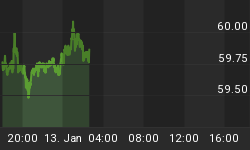Much has been made about the drop in COMEX gold stocks. COMEX gold stocks have fallen from 11.1 million ounces in the end of 2012 to just under 8 million ounces today. The bulk of the decline has occurred at the JP Morgan Chase Depository that has seen its stocks fall from 2.8 million ounces to just over 800 thousand ounces since late 2012. JP Morgan Chase is the depository for the SPDR Gold Trust (GLD-NYSE). Of the other four depositories, the Scotia Mocatta Depository has seen the largest decline from roughly 4 million ounces at the beginning of 2013 to 2.8 million ounces today. The other depositories are smaller and have remained relatively stable.

![]() Larger Image - Source: www.sharelynx.com
Larger Image - Source: www.sharelynx.com
The question that has been raised is does the COMEX have sufficient supplies on hand to meet demand if holders of gold futures were to demand delivery. In some respects, the question is moot. The vast majority of longs do not ask for delivery nor for that matter do the shorts have the metal to deliver. The vast majority of positions, long and short, are either covered for cash or rolled over to the next contract month. In a fast moving market, both up and down, it is the margin calls that may offer the best clue. If you are being sold out, it means you do not have the cash to stand for delivery.
While the COMEX stocks have fallen since late 2012, the stocks are considerably higher than they were in February 2001 at the market bottom and in January 1980 at the famous market top. In January 1980, stocks were roughly 2.3 million ounces and in February 2001 at the market bottom, they were about 1.8 million ounces. The peak in stocks was seen in August 2011 at 11.6 million ounces.
So what does all this mean? If stock were rising since 2001 that probably means that open interest was rising as well. And that has certainly been the case. In February 2001 at the market low open interest as expressed in millions of ounces was 14.6 million ounces. Today it stands at 45.3 million ounces and that is down from the peak in 2011 when at one point it was over 60 million ounces. It appears that has open interest rose, stocks rose and as open interest fell stocks fell as well.
Possibly a more efficient way of measuring as to whether there are sufficient stocks is take the ratio of open interest contracts to COMEX gold stocks. There is a chart of that ratio as provided by Sharelynx Gold www.sharelynx.com.

![]() Larger Image - Source: www.sharelynx.com
Larger Image - Source: www.sharelynx.com
The ratio today sits at 5.6 owners for each ounce of stock. The ratio has been rising. At year-end 2012 the ratio was 3.8 owners for each ounce of stock. In 2008 at the time of the financial crash, there was approximate 3.6 owners for each ounce of stock. Back in 2003 there was over 10 owners for each of stock. The peak was back in 1997 at the time of the Asian contagion crisis when there was over 44.1 owners for each ounce of stock. Other key dates were the January 1980 high when the coverage 8.7 owners for each ounce of gold stock and at the February 2001 low when the coverage was 8.3 owners for each ounce of gold stock.
The ratio has been rising but today it is lower than it was at the time of the January 1980 high, the February 2001 low and only slightly more than it was at the time of the August 2011 peak. While open interest has fallen since the beginning of 2013, stocks have also been falling but at a slightly faster pace.
Of potential greater concern is the decline in registered stocks. There are two types of stocks held in COMEX warehouses - eligible stocks and registered stocks. "Eligible" stocks meet COMEX requirements but do not have delivery receipts issued against them, whereas "registered" stocks are the only gold stocks used to meet COMEX futures delivery requests.
At year-end 2012, registered stocks totalled 2.3 million ounces vs. eligible stocks of 8.8 million ounces. Recent numbers show there are now 6.3 million ounces of eligible stocks a decline of 2.5 million ounces and 1.7 million ounces of registered stocks for a decline of 0.6 million ounces. Of more importance is the coverage. At year-end 2012, there were 18.6 owners per ounce of registered gold stock whereas the most recent numbers show there are 26.6 owners for each ounce of registered stock. Again as with the bigger picture, the trend has moved higher with more claims on each ounce of registered stock.
As with total stocks, it has to be put in perspective. It is not as high as it was in August 2011 at the market peak when there were 29.2 owners for each registered stock. It is, however, above the 2008 financial crash market low when it recorded 11.9 owners for each ounce of registered stock.
That the COMEX have fallen is not disputed. But has the decline created a potential crisis? While owners per ounce of stock or registered stock has gone up the levels are not yet at peak ratios. This suggests that the COMEX still should have sufficient stocks on an historical basis. However, if the ratio continues to rise it could become a concern.
















